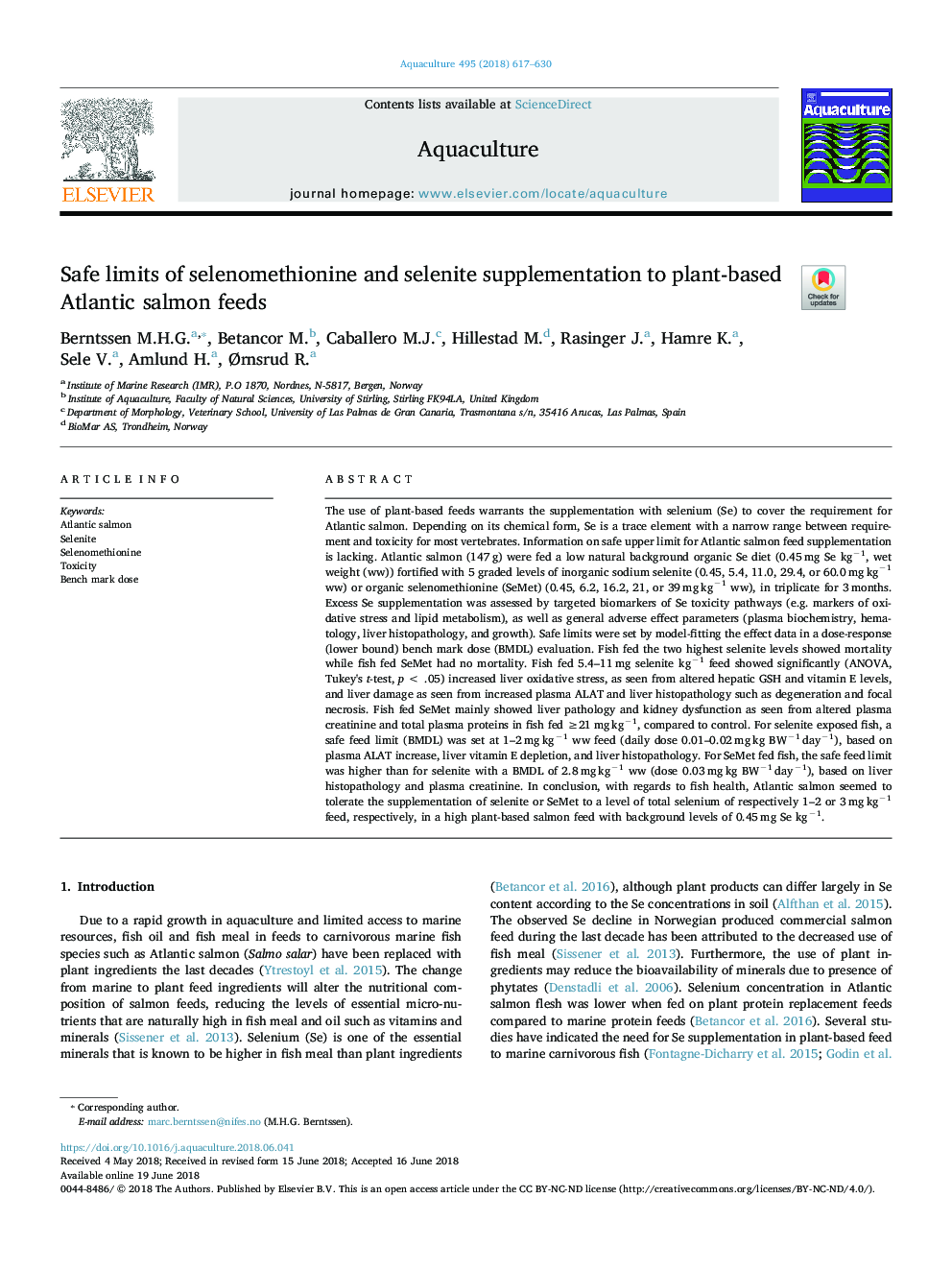| کد مقاله | کد نشریه | سال انتشار | مقاله انگلیسی | نسخه تمام متن |
|---|---|---|---|---|
| 8493054 | 1552793 | 2018 | 14 صفحه PDF | دانلود رایگان |
عنوان انگلیسی مقاله ISI
Safe limits of selenomethionine and selenite supplementation to plant-based Atlantic salmon feeds
ترجمه فارسی عنوان
محدودیت های ایمنی از سلنومتیونین و مکمل سلنیت به ماهی های آتلانتیک مبتنی بر گیاهان تغذیه می شود
دانلود مقاله + سفارش ترجمه
دانلود مقاله ISI انگلیسی
رایگان برای ایرانیان
کلمات کلیدی
ماهی سالمون دریای آتلانتیک، سلنیت، سلنمتینیون، سمی بودن دوز علامت پایه
موضوعات مرتبط
علوم زیستی و بیوفناوری
علوم کشاورزی و بیولوژیک
علوم آبزیان
چکیده انگلیسی
The use of plant-based feeds warrants the supplementation with selenium (Se) to cover the requirement for Atlantic salmon. Depending on its chemical form, Se is a trace element with a narrow range between requirement and toxicity for most vertebrates. Information on safe upper limit for Atlantic salmon feed supplementation is lacking. Atlantic salmon (147â¯g) were fed a low natural background organic Se diet (0.45â¯mg Se kgâ1, wet weight (ww)) fortified with 5 graded levels of inorganic sodium selenite (0.45, 5.4, 11.0, 29.4, or 60.0â¯mgâ¯kgâ1 ww) or organic selenomethionine (SeMet) (0.45, 6.2, 16.2, 21, or 39â¯mgâ¯kgâ1 ww), in triplicate for 3â¯months. Excess Se supplementation was assessed by targeted biomarkers of Se toxicity pathways (e.g. markers of oxidative stress and lipid metabolism), as well as general adverse effect parameters (plasma biochemistry, hematology, liver histopathology, and growth). Safe limits were set by model-fitting the effect data in a dose-response (lower bound) bench mark dose (BMDL) evaluation. Fish fed the two highest selenite levels showed mortality while fish fed SeMet had no mortality. Fish fed 5.4-11â¯mg selenite kgâ1 feed showed significantly (ANOVA, Tukey's t-test, pâ¯<â¯.05) increased liver oxidative stress, as seen from altered hepatic GSH and vitamin E levels, and liver damage as seen from increased plasma ALAT and liver histopathology such as degeneration and focal necrosis. Fish fed SeMet mainly showed liver pathology and kidney dysfunction as seen from altered plasma creatinine and total plasma proteins in fish fed â¥21â¯mgâ¯kgâ1, compared to control. For selenite exposed fish, a safe feed limit (BMDL) was set at 1-2â¯mgâ¯kgâ1 ww feed (daily dose 0.01-0.02â¯mgâ¯kg BWâ1â¯dayâ1), based on plasma ALAT increase, liver vitamin E depletion, and liver histopathology. For SeMet fed fish, the safe feed limit was higher than for selenite with a BMDL of 2.8â¯mgâ¯kgâ1 ww (dose 0.03â¯mgâ¯kg BWâ1â¯dayâ1), based on liver histopathology and plasma creatinine. In conclusion, with regards to fish health, Atlantic salmon seemed to tolerate the supplementation of selenite or SeMet to a level of total selenium of respectively 1-2 or 3â¯mgâ¯kgâ1 feed, respectively, in a high plant-based salmon feed with background levels of 0.45â¯mg Se kgâ1.
ناشر
Database: Elsevier - ScienceDirect (ساینس دایرکت)
Journal: Aquaculture - Volume 495, 1 October 2018, Pages 617-630
Journal: Aquaculture - Volume 495, 1 October 2018, Pages 617-630
نویسندگان
Berntssen M.H.G., Betancor M., Caballero M.J., Hillestad M., Rasinger J., Hamre K., Sele V., Amlund H., Ãrnsrud R.,
